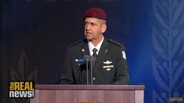1 feb 2019
Well, the new commander in chief of the Israeli army, Aviv Kochavi, thinks so. The previous Israeli Minister of Defense, Avigdor Lieberman, resigned in November to protest the ceasefire between Israel and Hamas, but still found time to install his favorite candidate to take over as chief of staff of the IDF, the Israeli Defense Forces. Benjamin Netanyahu, who has been serving as the acting minister of defense, as well as being prime minister, of course approved his nomination.
The man appointed, as we said, is Lieutenant General Aviv Kochavi. People know him popularly as the first vegetarian head of the Israeli Defense Forces. But that’s not what’s important. The significance runs much deeper than that. Here is a speech he gave upon being appointed.
AVIV KOCHAVI: Now, in my turn, as I have undertaken the responsibility to lead the army, I vow to to dedicate all of my efforts for a critical and demanding approach, to strengthen the protective wall and to adapt it to the challenges of the present and of the future. In focus: increasing the capacity to hit the enemy, and standing a deadlier, more efficient and innovative army, which remains true to its purpose and to its uniqueness.
MARC STEINER: Kochavi is known for his study of French philosophers Gilles Deleuze and Felix Guattari. He applied their innovative concept of space to lead Israeli troops in 2002 to the walls of homes in Balata refugee camp and Nablus, avoiding possible ambushes but ruining the lives of thousands of Palestinian families–something we will explore this conversation with our guest.
And our guest is Professor Eyal Weizman, who teaches spatial and visual cultures at Goldsmiths, University of London. He’s the founding director of the Center for Research Architecture and the director of research agency Forensic Architecture. His recent book is Forensic Architecture: Violence at the Threshold of Detectability, which was published in 2017 by Zone Books. And Eyal, welcome. Good to have you with us.
EYAL WEIZMAN: Good to be here.
MARC STEINER: Let’s start with this relationship, strange relationship, you have with Aviv Kochavi, who apparently sued you because of the work you were writing. Talk–tell us a bit about that background between the two of you, and how that came about, and what happened.
EYAL WEIZMAN: So, back in 2006 I published an English version of an article that exposed the existence of something like an architectural school or a theory special school for Israeli soldiers and officers, who were then at that time dealing with a relatively new field of military affair, and that is urban warfare. The military understood that in order to manage the complexities of urban warfare, the exist of many civilians, of media, the complex terrain, physically; the complex media sphere around urban warfare. They needed tools to understand action in complex environments. And that school was referred to the time as the Operational Theory Research Institute. Educated many officers reading what we were consider left-wing theories coming from urban studies and sociology, and indeed, also, art theory and philosophy like the theories of Gilles Deleuze and Guattari, mainly in the book A Thousand Plateaus.
And that work, in various of those terms, were introduced in developing various military forms of maneuver. For example, Gilles Deleuze and Felix Guattari introduced the concept of the rhizome, rhizometric movement or manoeuvre, by which multiple independent or semi-independent actors work in perfect coordination within a swarm through space, in which the military units are not contiguous and tightly held, but operating in a sort of wide diffusal. And that led to a very famous battle in those terms that was on the attack on the refugee camp of Ballata by Nablus, in which these theories were actually manifested. One of the leader of, the commander of the paratrooper brigade that undertook that maneuver was the same man who is now the Israeli chief of staff.
And what they have developed is a way in which a wide multiplicity of small groups would enter the refugee camp from different directions simultaneously, navigating through the build fabrics more like worms are making their way through an apple. In three dimensions, cutting walls full of holes, and through ceilings and floors, and move within it.
When I have written about it, in English there was no–there was very positive response from the academic community. But the problem began when we wanted to translate that article into Hebrew. And at that moment the–one of the staple, one of the most important left-wing journal, theory journal in Israel, theory criticism, accepted it for publication. But sent this essay to the Israeli army for a response, something that I consider to be completely unacceptable. Instead of a response they have received a threat of legal action on behalf of Kohavi, the current Israeli chief of staff, for threat to withdraw that article from publication.
What they complained about was several factual things to do with numbers of casualties. Of course, I stand by my sources.
MARC STEINER: So what was at the heart, though, of why they–why would they go after an academic article? What was it at the heart of it, in short, about why they went after you? But then they also backed off and dropped it at the end, correct?
EYAL WEIZMAN: Yeah. At the end they backed off because the, I think many in the Israeli left-wing academic community understood that this is an unacceptable move. First, it was unacceptable by the journal, by Theory and Criticism, to send it to the military, and then for the military to exercise any kind of pressure. They have their own means to do it. There is military censorship. There’s all sorts of means that they have to try to silence critique in an intellectual academic debate.
As critical as it may be, and I’m extremely critical of the Israeli military human rights record and behavior in general in relation to the Israeli occupation, or colonization, of the West Bank and Gaza. They were trying to shut down this thing because it was, I think, inconvenient for them for these facts to be released. It was considered as embarrassing for them that these theories and these sources actually be used for military purposes.
MARC STEINER: So last year over 250 Palestinians were killed in Gaza by Israeli troops. Most of them are unarmed protesters. They were shot with sniper fire. And Palestinians have no army. The Israeli Army has enough ammunition to kill as many Palestinians as it wants. So what does Aviv Kochavi mean that he vows to make the Israeli military deadlier? How much deadlier can they be? And is there an implied criticism there of the former head of the military?
EYAL WEIZMAN: There is continuous debate, political debate, within the Israeli right and extreme right about who can show to the Israeli electorate, to the Israeli public, that they’re tougher with the Palestinians, as if Israel is not been tough enough. As if there is no peace because Israel shows any weakness. I mean, this is obviously ridiculous. But this is a commodity that can circulate very well within the Israeli electorate. You see here now the alternative, the big alternative to Netanyahu.
Another former chief of staff, Gantz, has yesterday made a speech. And in fact, his entire campaign he’s running, how many Arabs, or many terrorists he claimed to have killed. This is in the hundreds or thousands. I don’t have the exact number here. But that, the fact that this is a currency in the Israeli public domain is extremely disturbing. That, you know, that even the left or the alternative from the left to Benjamin Netanyahu needs to make inroads here to the public by claiming to be deadly is absolutely frustrating for us in the left and anticolonial movement in Israel.
MARC STEINER: So I’m very curious, as we close this out together, in your book Hollow Land, you kind of show that there were two factions inside the Israeli senior command, which you call kind of the more philosophical officers like Shimon Naveh and others versus more simply–the simple, straight ahead officers like Moshe Ya’alon. In recent years we’ve seen the latter becoming much more dominant in the Israeli army, calling for application of brute force rather than sophisticated colonial domination. So what do you think is at foot here. Does the appointment of Kochavi portend something really different? I mean, where does he really stand on all this? What does it all really mean, and how deep is that divide?
EYAL WEIZMAN: You see, that’s the structural problem of the Israeli occupation of the West Bank. They want to control that space without being there in the heart of the Palestinian areas. They need to develop forms of surveillance, forms of attack, and forms of maneuver that allow them to go in and out very fast so that they can claim there is no occupation. We are not in Bethlehem. We are not in–in Hebron, yes. But we’re not in the other major Palestinian cities, like Nablus. Whereas effectively they exercise complete control over the lives of all Palestinian citizens between the river and the sea, whether it is through the population register, whether it is through surveillance, whether it is through their ability to strike and kill, in fact, anyone that they want to.
So the idea is how to make the occupation invisible, how to develop new forms of control, of manoeuvre. And if you need to, to enlist the new technologies and new critical theories, all the best, in order to kind of, to live with that paradox. We need to go on–they want to go on dominating the Palestinians. But they want to go out to say to the world we are, in fact, outside the population center. There is no occupation. There is some kind of situation that needs to be resolved.
MARC STEINER: This’ll be really interesting to watch how this unfolds, and I can’t help but think, just knowing a lot about him and who he is, what this could portend for the future in terms of the military and their tactics, and what’s going to happen with the Israelis and Palestinians. Eyal Weizman, it’s been a pleasure to have you with us. I appreciate your work. Appreciate your taking the time today with The Real News. I look forward to talking to you again as soon as we can.
EYAL WEIZMAN: Thank you very much.
MARC STEINER: I’m Marc Steiner here for The Real News Network. Thank you all so much for being with us. Take care.
The man appointed, as we said, is Lieutenant General Aviv Kochavi. People know him popularly as the first vegetarian head of the Israeli Defense Forces. But that’s not what’s important. The significance runs much deeper than that. Here is a speech he gave upon being appointed.
AVIV KOCHAVI: Now, in my turn, as I have undertaken the responsibility to lead the army, I vow to to dedicate all of my efforts for a critical and demanding approach, to strengthen the protective wall and to adapt it to the challenges of the present and of the future. In focus: increasing the capacity to hit the enemy, and standing a deadlier, more efficient and innovative army, which remains true to its purpose and to its uniqueness.
MARC STEINER: Kochavi is known for his study of French philosophers Gilles Deleuze and Felix Guattari. He applied their innovative concept of space to lead Israeli troops in 2002 to the walls of homes in Balata refugee camp and Nablus, avoiding possible ambushes but ruining the lives of thousands of Palestinian families–something we will explore this conversation with our guest.
And our guest is Professor Eyal Weizman, who teaches spatial and visual cultures at Goldsmiths, University of London. He’s the founding director of the Center for Research Architecture and the director of research agency Forensic Architecture. His recent book is Forensic Architecture: Violence at the Threshold of Detectability, which was published in 2017 by Zone Books. And Eyal, welcome. Good to have you with us.
EYAL WEIZMAN: Good to be here.
MARC STEINER: Let’s start with this relationship, strange relationship, you have with Aviv Kochavi, who apparently sued you because of the work you were writing. Talk–tell us a bit about that background between the two of you, and how that came about, and what happened.
EYAL WEIZMAN: So, back in 2006 I published an English version of an article that exposed the existence of something like an architectural school or a theory special school for Israeli soldiers and officers, who were then at that time dealing with a relatively new field of military affair, and that is urban warfare. The military understood that in order to manage the complexities of urban warfare, the exist of many civilians, of media, the complex terrain, physically; the complex media sphere around urban warfare. They needed tools to understand action in complex environments. And that school was referred to the time as the Operational Theory Research Institute. Educated many officers reading what we were consider left-wing theories coming from urban studies and sociology, and indeed, also, art theory and philosophy like the theories of Gilles Deleuze and Guattari, mainly in the book A Thousand Plateaus.
And that work, in various of those terms, were introduced in developing various military forms of maneuver. For example, Gilles Deleuze and Felix Guattari introduced the concept of the rhizome, rhizometric movement or manoeuvre, by which multiple independent or semi-independent actors work in perfect coordination within a swarm through space, in which the military units are not contiguous and tightly held, but operating in a sort of wide diffusal. And that led to a very famous battle in those terms that was on the attack on the refugee camp of Ballata by Nablus, in which these theories were actually manifested. One of the leader of, the commander of the paratrooper brigade that undertook that maneuver was the same man who is now the Israeli chief of staff.
And what they have developed is a way in which a wide multiplicity of small groups would enter the refugee camp from different directions simultaneously, navigating through the build fabrics more like worms are making their way through an apple. In three dimensions, cutting walls full of holes, and through ceilings and floors, and move within it.
When I have written about it, in English there was no–there was very positive response from the academic community. But the problem began when we wanted to translate that article into Hebrew. And at that moment the–one of the staple, one of the most important left-wing journal, theory journal in Israel, theory criticism, accepted it for publication. But sent this essay to the Israeli army for a response, something that I consider to be completely unacceptable. Instead of a response they have received a threat of legal action on behalf of Kohavi, the current Israeli chief of staff, for threat to withdraw that article from publication.
What they complained about was several factual things to do with numbers of casualties. Of course, I stand by my sources.
MARC STEINER: So what was at the heart, though, of why they–why would they go after an academic article? What was it at the heart of it, in short, about why they went after you? But then they also backed off and dropped it at the end, correct?
EYAL WEIZMAN: Yeah. At the end they backed off because the, I think many in the Israeli left-wing academic community understood that this is an unacceptable move. First, it was unacceptable by the journal, by Theory and Criticism, to send it to the military, and then for the military to exercise any kind of pressure. They have their own means to do it. There is military censorship. There’s all sorts of means that they have to try to silence critique in an intellectual academic debate.
As critical as it may be, and I’m extremely critical of the Israeli military human rights record and behavior in general in relation to the Israeli occupation, or colonization, of the West Bank and Gaza. They were trying to shut down this thing because it was, I think, inconvenient for them for these facts to be released. It was considered as embarrassing for them that these theories and these sources actually be used for military purposes.
MARC STEINER: So last year over 250 Palestinians were killed in Gaza by Israeli troops. Most of them are unarmed protesters. They were shot with sniper fire. And Palestinians have no army. The Israeli Army has enough ammunition to kill as many Palestinians as it wants. So what does Aviv Kochavi mean that he vows to make the Israeli military deadlier? How much deadlier can they be? And is there an implied criticism there of the former head of the military?
EYAL WEIZMAN: There is continuous debate, political debate, within the Israeli right and extreme right about who can show to the Israeli electorate, to the Israeli public, that they’re tougher with the Palestinians, as if Israel is not been tough enough. As if there is no peace because Israel shows any weakness. I mean, this is obviously ridiculous. But this is a commodity that can circulate very well within the Israeli electorate. You see here now the alternative, the big alternative to Netanyahu.
Another former chief of staff, Gantz, has yesterday made a speech. And in fact, his entire campaign he’s running, how many Arabs, or many terrorists he claimed to have killed. This is in the hundreds or thousands. I don’t have the exact number here. But that, the fact that this is a currency in the Israeli public domain is extremely disturbing. That, you know, that even the left or the alternative from the left to Benjamin Netanyahu needs to make inroads here to the public by claiming to be deadly is absolutely frustrating for us in the left and anticolonial movement in Israel.
MARC STEINER: So I’m very curious, as we close this out together, in your book Hollow Land, you kind of show that there were two factions inside the Israeli senior command, which you call kind of the more philosophical officers like Shimon Naveh and others versus more simply–the simple, straight ahead officers like Moshe Ya’alon. In recent years we’ve seen the latter becoming much more dominant in the Israeli army, calling for application of brute force rather than sophisticated colonial domination. So what do you think is at foot here. Does the appointment of Kochavi portend something really different? I mean, where does he really stand on all this? What does it all really mean, and how deep is that divide?
EYAL WEIZMAN: You see, that’s the structural problem of the Israeli occupation of the West Bank. They want to control that space without being there in the heart of the Palestinian areas. They need to develop forms of surveillance, forms of attack, and forms of maneuver that allow them to go in and out very fast so that they can claim there is no occupation. We are not in Bethlehem. We are not in–in Hebron, yes. But we’re not in the other major Palestinian cities, like Nablus. Whereas effectively they exercise complete control over the lives of all Palestinian citizens between the river and the sea, whether it is through the population register, whether it is through surveillance, whether it is through their ability to strike and kill, in fact, anyone that they want to.
So the idea is how to make the occupation invisible, how to develop new forms of control, of manoeuvre. And if you need to, to enlist the new technologies and new critical theories, all the best, in order to kind of, to live with that paradox. We need to go on–they want to go on dominating the Palestinians. But they want to go out to say to the world we are, in fact, outside the population center. There is no occupation. There is some kind of situation that needs to be resolved.
MARC STEINER: This’ll be really interesting to watch how this unfolds, and I can’t help but think, just knowing a lot about him and who he is, what this could portend for the future in terms of the military and their tactics, and what’s going to happen with the Israelis and Palestinians. Eyal Weizman, it’s been a pleasure to have you with us. I appreciate your work. Appreciate your taking the time today with The Real News. I look forward to talking to you again as soon as we can.
EYAL WEIZMAN: Thank you very much.
MARC STEINER: I’m Marc Steiner here for The Real News Network. Thank you all so much for being with us. Take care.
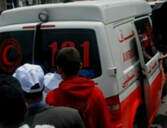
A Palestinian has teenager sustained multiple fractures in his legs after being assaulted by Israeli soldiers near Jenin city, in the northern West Bank, according to the Palestinian Red Crescent (PRC).
PRC official, Mahmoud Saadi, told WAFA that 17-year-old Majdi Abu-Ghali, from Jenin, was beaten severely, by Israeli soldiers, after he entered the site of the abandoned Israeli settlement of Ghanim, east of Jenin.
The teen was reportedly unaware of the Israeli soldiers who had raided the evacuated settlement, and was surprised by soldiers who shortly attacked and brutally beat him for no reason.
The teenager was moved to nearby Khalil Suleiman public hospital for medical treatment.
Israeli occupation forces have a long record of physically assaulting Palestinians while briefly detaining them. Earlier today, an Israeli court indicted five Israeli soldiers for beating two handcuffed and blindfolded Palestinian detainees.
According to the indictment, on a day in early January, the soldiers punched, slapped, kicked and beat the two detainees, hitting them in their head, face, chest, legs and more.
PRC official, Mahmoud Saadi, told WAFA that 17-year-old Majdi Abu-Ghali, from Jenin, was beaten severely, by Israeli soldiers, after he entered the site of the abandoned Israeli settlement of Ghanim, east of Jenin.
The teen was reportedly unaware of the Israeli soldiers who had raided the evacuated settlement, and was surprised by soldiers who shortly attacked and brutally beat him for no reason.
The teenager was moved to nearby Khalil Suleiman public hospital for medical treatment.
Israeli occupation forces have a long record of physically assaulting Palestinians while briefly detaining them. Earlier today, an Israeli court indicted five Israeli soldiers for beating two handcuffed and blindfolded Palestinian detainees.
According to the indictment, on a day in early January, the soldiers punched, slapped, kicked and beat the two detainees, hitting them in their head, face, chest, legs and more.
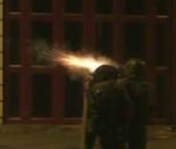
Israeli soldiers shot and abducted, on Thursday at night, a young Palestinian man near the al-Khader town, south of Bethlehem in the occupied West Bank.
Local sources said the soldiers shot the young man with a live round in his leg, and abducted him, before moving him to a hospital in Jerusalem; his condition remains unknown.
The Israeli army claims that the young man hurled a Molotov cocktail at a military monitoring post near al-Khader.
It is worth mentioning that al-Khader has been subject to constant military invasions, violent searches of homes, which included abductions of many residents, especially youngsters.
In related news, the soldiers invaded Teqoua’ town, southeast of the West Bank city of Bethlehem, and fired live rounds at schoolchildren protesting the invasion, wounding three of them, including two who suffered serious injuries.
Local sources said the soldiers shot the young man with a live round in his leg, and abducted him, before moving him to a hospital in Jerusalem; his condition remains unknown.
The Israeli army claims that the young man hurled a Molotov cocktail at a military monitoring post near al-Khader.
It is worth mentioning that al-Khader has been subject to constant military invasions, violent searches of homes, which included abductions of many residents, especially youngsters.
In related news, the soldiers invaded Teqoua’ town, southeast of the West Bank city of Bethlehem, and fired live rounds at schoolchildren protesting the invasion, wounding three of them, including two who suffered serious injuries.
31 jan 2019
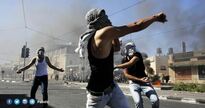
Three Palestinians were injured on Thursday afternoon as clashes broke out with Israeli Occupation Forces (IOF) in Tuqu town, south of the southern West Bank city of Bethlehem.
The clashes erupted when IOF soldiers opened live fire and showered the resident with tear gas canisters leaving three wounded and many suffocation cases.
2 Palestinian students critically injured with Israeli live fire in Tuqu
Three Palestinian students were injured with Israeli live ammunition, on Thursday, in the Tuqu village, southeast of the southern occupied West Bank district of Bethlehem.
According to local sources, Israeli forces stormed the Tuqu village and surrounded a local high school, leading to clashes among Israeli forces and Palestinian students.
Sources said Israeli forces fired live ammunition and tear-gas bombs at the students to disperse them. Three students were shot with live ammunition, while dozens of others suffered from tear-gas inhalation.
The Palestinian Red Crescent Society (PRCS) confirmed that its medical crews transferred three Palestinians, who suffered injuries in their abdomen, pelvis, and leg, to a nearby hospital.
PRCS also confirmed that two of the three students are in critical condition.
Many Palestinians schools and universities have been subjected to numerous Israeli military raids in the past.
The United Nations Office for the Coordination of Humanitarian Affairs (OCHA) in the Occupied Palestinian Territory confirmed that since the beginning of 2018 there has been a significant increase in incidents involving the entry of Israeli forces and settlers into Palestinian schools.
In OCHA’s biweekly Protection of Civilians Report covering the period from 6th to 19th of November 2018, it said that in the West Bank, 63 Palestinian children and nine adults were injured by Israeli forces during four separate raids into schools, one of which also involved Israeli settlers.
The clashes erupted when IOF soldiers opened live fire and showered the resident with tear gas canisters leaving three wounded and many suffocation cases.
2 Palestinian students critically injured with Israeli live fire in Tuqu
Three Palestinian students were injured with Israeli live ammunition, on Thursday, in the Tuqu village, southeast of the southern occupied West Bank district of Bethlehem.
According to local sources, Israeli forces stormed the Tuqu village and surrounded a local high school, leading to clashes among Israeli forces and Palestinian students.
Sources said Israeli forces fired live ammunition and tear-gas bombs at the students to disperse them. Three students were shot with live ammunition, while dozens of others suffered from tear-gas inhalation.
The Palestinian Red Crescent Society (PRCS) confirmed that its medical crews transferred three Palestinians, who suffered injuries in their abdomen, pelvis, and leg, to a nearby hospital.
PRCS also confirmed that two of the three students are in critical condition.
Many Palestinians schools and universities have been subjected to numerous Israeli military raids in the past.
The United Nations Office for the Coordination of Humanitarian Affairs (OCHA) in the Occupied Palestinian Territory confirmed that since the beginning of 2018 there has been a significant increase in incidents involving the entry of Israeli forces and settlers into Palestinian schools.
In OCHA’s biweekly Protection of Civilians Report covering the period from 6th to 19th of November 2018, it said that in the West Bank, 63 Palestinian children and nine adults were injured by Israeli forces during four separate raids into schools, one of which also involved Israeli settlers.
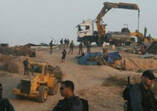
Israeli soldiers invaded, Thursday, a Palestinian home in the Sahla area, in the Old City of Hebron, in the southern part of the occupied West Bank, before assaulting the family, in addition to destroying their furniture.
Hazem Abu Rajab, said the soldiers invaded his home, and assaulted his family, before confiscating his car.
He added that the soldiers violently searched the property, and deliberately caused damage to the furniture and belongings.
Since the year 2012, the family has been subject to frequent invasions and violations by the army, and the illegal colonialist settlers, who claim to own part of the three-story building, inhabited by fourteen members of Abu Rajab family.
The family has been fighting the ongoing illegal takeover attempts by the colonialist settlers, while Israeli courts are still deliberating the case.
Hazem said the latest invasion, and assault was carried out after he refused to sign documents without fully knowing their contents and added that the incident was reported to the Legal Branch of the Hebron Construction Committee, so that it can conduct all needed measures.
The property is a three-story building, inhabited by fourteen members of Abu Rajab family.
Hazem Abu Rajab, said the soldiers invaded his home, and assaulted his family, before confiscating his car.
He added that the soldiers violently searched the property, and deliberately caused damage to the furniture and belongings.
Since the year 2012, the family has been subject to frequent invasions and violations by the army, and the illegal colonialist settlers, who claim to own part of the three-story building, inhabited by fourteen members of Abu Rajab family.
The family has been fighting the ongoing illegal takeover attempts by the colonialist settlers, while Israeli courts are still deliberating the case.
Hazem said the latest invasion, and assault was carried out after he refused to sign documents without fully knowing their contents and added that the incident was reported to the Legal Branch of the Hebron Construction Committee, so that it can conduct all needed measures.
The property is a three-story building, inhabited by fourteen members of Abu Rajab family.
30 jan 2019

Israeli soldiers abducted, earlier Wednesday, four Palestinians, from Hebron governorate, in the southern part of the occupied West Bank, and inured one after repeatedly assaulting him.
The soldiers invaded Beit Ummar town, north of Hebron, searched homes and abducted Mahmoud Suleiman Ekhlayyel.
The soldiers also invaded homes in Yatta town, south of Hebron, and abducted Mohammad Jibreel Salama.
Another Palestinian, identified as Baha Ghneimat, was taken prisoner in Surif town, northwest of Hebron.
In addition, the soldiers invaded the al-‘Arroub refugee camp, north of Hebron, and abducted Maher Abu Warda, from his home, in addition to firing gas bombs and concussion grenades at local protesters.
Furthermore, the soldiers abducted Firas Mohammad al-Baw, from Halhoul town, north of Hebron, while working in occupied Jerusalem, causing many cuts and bruises, before releasing him at Tarqoumia roadblock, west of Hebron.
The Palestinian was instantly moved to the Hebron Governmental Hospital for treatment, suffering moderate wounds.
It is worth mentioning that the soldiers invaded many neighborhoods in Hebron city, and installed roadblocks on the main entrances of Yatta, Ethna, Doura, Deir Samit, Beit Awwa and Halhoul, in addition to Hebron’s northern road, before stopping and searching dozens of cars, and interrogated many Palestinians while invoicing their ID cards.
The soldiers invaded Beit Ummar town, north of Hebron, searched homes and abducted Mahmoud Suleiman Ekhlayyel.
The soldiers also invaded homes in Yatta town, south of Hebron, and abducted Mohammad Jibreel Salama.
Another Palestinian, identified as Baha Ghneimat, was taken prisoner in Surif town, northwest of Hebron.
In addition, the soldiers invaded the al-‘Arroub refugee camp, north of Hebron, and abducted Maher Abu Warda, from his home, in addition to firing gas bombs and concussion grenades at local protesters.
Furthermore, the soldiers abducted Firas Mohammad al-Baw, from Halhoul town, north of Hebron, while working in occupied Jerusalem, causing many cuts and bruises, before releasing him at Tarqoumia roadblock, west of Hebron.
The Palestinian was instantly moved to the Hebron Governmental Hospital for treatment, suffering moderate wounds.
It is worth mentioning that the soldiers invaded many neighborhoods in Hebron city, and installed roadblocks on the main entrances of Yatta, Ethna, Doura, Deir Samit, Beit Awwa and Halhoul, in addition to Hebron’s northern road, before stopping and searching dozens of cars, and interrogated many Palestinians while invoicing their ID cards.
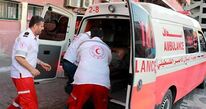
A Palestinian man was shot on Tuesday by the Israeli occupation forces in northern Gaza.
Gaza's Ministry of Health said that a 45-year-old Palestinian farmer was injured by Israeli gunfire in Beit Lahia city in the northern area of the Gaza Strip.
Local sources said that the man was shot while he was working in his farmland, and was later transferred to a local hospital for treatment.
Gaza's Ministry of Health said that a 45-year-old Palestinian farmer was injured by Israeli gunfire in Beit Lahia city in the northern area of the Gaza Strip.
Local sources said that the man was shot while he was working in his farmland, and was later transferred to a local hospital for treatment.
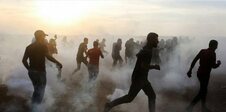
At least 14 Palestinians were shot and injured with live ammunition, and 11 others suffocated from tear gas inhalation as Israeli forces continued to attack the ‘Great March of Return’ protests at the Gaza-Israel border, said WAFA sources.
Israeli forces stationed at military watchtowers along the barbed-wire fence between Israel and Gaza, to the northwest of Beit Lahiya town, in the northern Gaza Strip, fired live bullets and tear gas canisters toward the protesters, shooting and injuring at least 14 Palestinians.
Their medical condition is still unknown.
Eleven others suffocated due to tear gas inhalation.
Israeli forces stationed at military watchtowers along the barbed-wire fence between Israel and Gaza, to the northwest of Beit Lahiya town, in the northern Gaza Strip, fired live bullets and tear gas canisters toward the protesters, shooting and injuring at least 14 Palestinians.
Their medical condition is still unknown.
Eleven others suffocated due to tear gas inhalation.
29 jan 2019
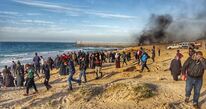
At least 18 Palestinians were shot and injured Tuesday evening by Israeli forces' gunfire as they suppressed the weekly naval march in the northern besieged Gaza Strip.
Medical sources said that Israeli forces opened live fire, rubber-coated steel bullets and tear-gas bombs to suppress protesters and boats attempting to break the siege.
Eight protesters suffered gunshot injuries while the others were hit with teargas bombs, the sources added.
Hundreds of Palestinian protesters gathered on Tuesday afternoon at the northern borders of the Gaza Strip to take part in protests in an attempt to break the siege imposed on the Gaza Strip for more than 12 years.
Medical sources said that Israeli forces opened live fire, rubber-coated steel bullets and tear-gas bombs to suppress protesters and boats attempting to break the siege.
Eight protesters suffered gunshot injuries while the others were hit with teargas bombs, the sources added.
Hundreds of Palestinian protesters gathered on Tuesday afternoon at the northern borders of the Gaza Strip to take part in protests in an attempt to break the siege imposed on the Gaza Strip for more than 12 years.
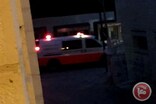
One Palestinian was shot and injured by Israeli forces' live fire, late Monday, in eastern Khan Younis in the southern besieged Gaza Strip.
Witnesses told Ma'an that Israeli soldiers opened fire towards a Palestinian youth who was walking near the Israeli border fence in eastern Abasan al-Jadida.
The youth was injured and transferred to a hospital for treatment.
Israeli forces regularly detain Palestinians attempting to cross into Israel from the besieged Gaza Strip, which has suffered under a nearly 12-year-long military blockade by Israel.
Witnesses told Ma'an that Israeli soldiers opened fire towards a Palestinian youth who was walking near the Israeli border fence in eastern Abasan al-Jadida.
The youth was injured and transferred to a hospital for treatment.
Israeli forces regularly detain Palestinians attempting to cross into Israel from the besieged Gaza Strip, which has suffered under a nearly 12-year-long military blockade by Israel.
